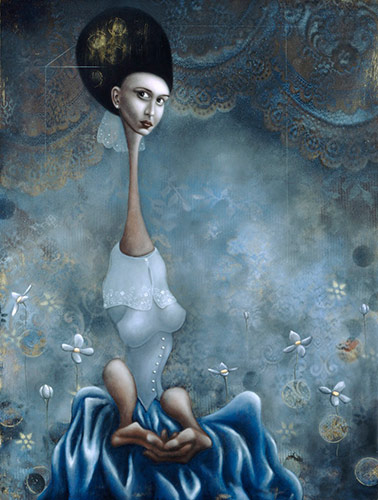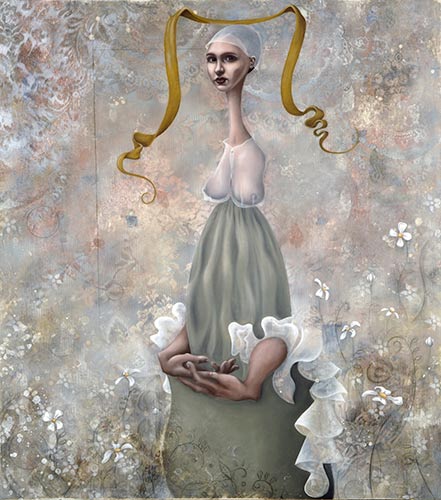One could argue that human nature dictates we contemplate some of life’s biggest questions: Why are we here? Who made us? And what happens after this? While we all have our individual ways of understanding these unknowns, art has — since its prehistoric beginnings — been an outstanding representation of this primal endeavor. Connecting himself to this tradition — and others — is painter Nicholas Harper, whose glittering multimedia pictures provide moments of self-reflection in himself and his viewers.
Like so many artists before him, Nicholas Harper’s creative process is an epic voyage that relies on years of experience, various traditions, and multiple sources of inspiration. Even so, art has always empowered creative minds to end that journey in beautifully original ways, and Harper’s work does just that. For Harper, “Inspiration for any particular piece is usually born out of a long process of internalizing ideas or ‘notes’ from passages in books I might be reading, movies watched, music, or conversation,” he says. “I usually work on a number of pieces at the same time, and while an initial sketch of an idea may be rendered relatively quickly after the first spark of inspiration, it can take months to re-approach the sketch and commit to it as a painting. Oftentimes the leading idea will have been redrawn in my mind several times and rarely does the finished product resemble what I originally conceived.”

Nicholas Harper, “Paris,” oil and mixed media on panel, (c) Nicholas Harper 2015
Caught somewhere between representation and abstraction, the style of Harper’s art is mesmerizing, often juxtaposing two-dimensional patterning and gold leaf with captivating and naturalistic faces and hands. The play between two and three dimensions commands extended meditation from the viewer.
Building upon Russian and Byzantine iconographic traditions, works such as “Helios” present the figure with golden halos — an element of importance for Harper. “It is my hope to elevate the figure to the status of symbol and allegory,” he suggests. “The figure is used to create a point of entry or access by the viewer into the work and it’s meanings.” Speaking of the influence of religious icons, Harper adds, “Of particular interest to me is the degree to which the process of making an icon is meant to be a prayer or meditation on the mystical understandings of God, man, and nature. The gold halo, for example, is a direct reference to the spirit that lies within each of us. The process of applying the gold leaf in the Russian tradition directly mimics passages from the Bible in which God breathes life into clay, creating Adam.”

Nicholas Harper, “Susannah,” oil and mixed media on panel, (c) Nicholas Harper 2015
Once the viewer has granted Harper’s “point of entry,” narrative comes to the fore. He writes, “I have over the years created a symbolic narrative of my own to relate to what I see as a push and pull struggle within people, between our worldly natures and our divine potential. For example, the head in many of my portraits represent the divine, while the hands represent the worldly. They are disconnected from each other and separated further by the use of a long neck, giving a visual cue to the nature of the individual. However, if the viewer steps away from the piece and looks at the painting as a whole, it takes on a completeness, alluding to the idea that this inner tension most of us feel is illusory or only existent based on perspective.”

Nicholas Harper, “Untitled,” oil and mixed media on panel, (c) Nicholas Harper 2015
The parts of Harper’s pictures work in conjunction with one another to achieve his artistic goals, including the traditional, uniform, and smooth surface texture. “I will often use a gloss varnish as well,” the artist says. “In this way I tend to think of the painting as a mirror that the viewer might see himself or herself in.” Certainly, it is self-reflection that Harper is after, both in himself and his viewers. He continues, “My primary goal in art is to better understand myself as a person by using the art-making process as a form of contemplation, meditation and prayer. Secondly I would like to create something that can be of value in a similar way to those who view and acquire my work. Just as icons where used as points of meditation in the home, so too I wish for my work to be a focal point in the home and an object capable of sparking self reflection.”

Nicholas Harper, “Brida,” oil and mixed media on panel, (c) Nicholas Harper 2015
Recently, Harper has been exploring more multimedia materials in his work, a feature he hopes to increase in the future. “I know I’ll be painting in five years,” he says, “though I have no idea what I’ll be painting. I’m sure it will probably still revolve around the figure, but hopefully it will have transformed as I will have transformed in my own life. I believe that as an artist grows and changes, so should their work. I hope to have gained a further understanding of myself and the universe I am part of while developing continued humility in understanding that I probably will never know the answers to life’s biggest questions.”
Harper opens a solo exhibition entitled “OPULENCE: A Masquerade” at Rogue Buddha Gallery tomorrow, December 11, in Minneapolis, Minnesota.
To learn more, visit Rogue Buddha Gallery.
This article was featured in Fine Art Today, a weekly e-newsletter from Fine Art Connoisseur magazine. To start receiving Fine Art Today for free, click here.







